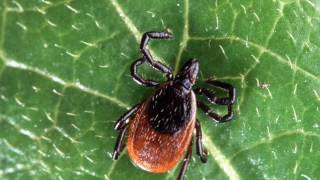Tick-Transmitted Anaplasmosis Bite is Worse Than Lyme Disease

Reported cases of a tick-borne disease are swelling in Maine this year, but it’s not Lyme Disease.
Cases of anaplasmosis, an illness similar to Lyme Disease, has reached 433 reported case through Oct. 24, 2017, according to the Maine Center for Disease Control and Prevention.
This is a significant increase from 2012, when only 52 cases were reported.
Of these 2017 Anaplasmosis cases, 113 patients were hospitalized, according to Maine CDC statistics.
Anaplasmosis cases are also rising in other New England states, such as in Massachusetts, which reported 828 cases in 2016 compared to about 200 in 2012.
About 25 percent of all anaplasmosis cases result in hospitalizations, compared to 5 percent of Lyme cases.
Anaplasmosis is a tickborne disease with flu-like symptoms caused by the bacterium Anaplasma phagocytophilum, an infection of the white blood cells.
Anaplasmosis is caused by Anaplasma phagocytophilum. It is an intracellular pathogen that is part of the Rickettsia family, the same group of bacteria that cause Rocky Mountain spotted fever.
It was previously known as human granulocytic ehrlichiosis (HGE) and has more recently been called human granulocytic anaplasmosis (HGA).
Anaplasmosis is transmitted to humans by tick bites primarily from the black-legged tick (Ixodes scapularis) and the western black-legged tick (Ixodes pacificus).
These are the same ticks that transmit Lyme disease.
Moreover, co-infections between Lyme and Anaplasmosis have been reported.
Typical symptoms include: fever, headache, chills, and muscle aches. Usually, these symptoms occur within 1-2 weeks of a tick bite. The first line treatment for adults and children of all ages is doxycycline. Anaplasmosis and other tickborne diseases can be prevented.
“Part of the issue is greater awareness and more testing by people who fall ill. But also, more deer ticks are infected with anaplasmosis and passing the bacteria on to humans,” said Chuck Lubelczyk, a field biologist with the Maine Medical Center Research Institute in Scarborough.
Anaplasmosis symptoms are flu-like and can include fever, chills, fatigue and joint pain.
Sara Robinson, a Maine CDC epidemiologist, said “Anaplasmosis is more difficult to detect than Lyme, as anaplasmosis does not have the “bull’s-eye” rash that appears in some infected with Lyme, signaling that they have the disease.”
Robinson said “The best way to tell is if you’re feeling like you have the flu, outside of October to May flu season.”
Since there is not a human vaccine for anaplasmosis available, prevention is key.
Wear long clothing and repellents when in tick habitat, such as the woods. In most cases, ticks need to be attached to a human for 36 hours before diseases can be transmitted.
Our Trust Standards: Medical Advisory Committee
- Anaplasmosis
- Annual Cases of Anaplasmosis in the United States
- Tick Borne Diseases
- Human Granulocytic Ehrlichiosis (HGE)
- Tick-borne anaplasmosis surging in Maine – and it’s worse than Lyme
- Antigens and Alternatives for Control of Anaplasma marginale Infection in Cattle
- Tick-Borne Emerging Infections: Ehrlichiosis and Anaplasmosis.
- Anaplasma marginale and Anaplasma phagocytophilum: Rickettsiales pathogens of veterinary and public health significance


